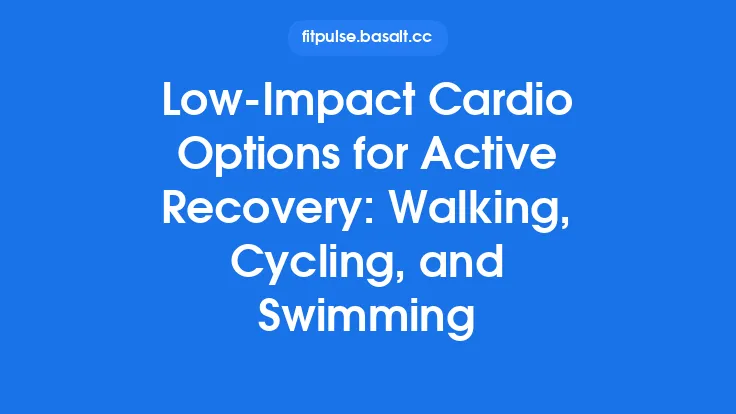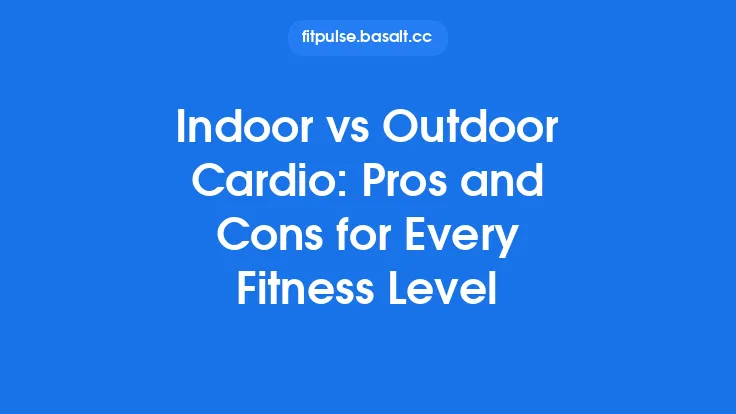When it comes to cardiovascular conditioning, the right equipment can make the difference between a workout that feels like a chore and one that fuels progress, comfort, and safety. Whether you’re pounding the pavement, conquering hills on two wheels, slicing through the water, or pulling through a rowing machine, each modality has its own set of essential tools that have stood the test of time. This guide walks you through the core pieces of gear every runner, cyclist, swimmer, and rower should consider, why they matter, and how to choose the best options for your goals, body type, and budget.
Core Principles for Selecting Cardio Gear
Before diving into modality‑specific recommendations, it’s helpful to keep a few universal criteria in mind:
| Criterion | Why It Matters | How to Evaluate |
|---|---|---|
| Fit & Comfort | Ill‑fitting gear can cause chafing, pressure points, and long‑term injury. | Try on equipment in motion (e.g., jog in shoes, pedal on a stationary bike) and check for secure but non‑restrictive contact. |
| Durability & Materials | Frequent use demands gear that withstands sweat, UV exposure, and mechanical stress. | Look for high‑denier fabrics, reinforced stitching, and corrosion‑resistant metals or composites. |
| Functionality vs. Weight | Extra features can be useful, but added mass may hinder performance, especially in endurance events. | Prioritize multi‑functional items (e.g., shoes with integrated cushioning) and compare weight specs. |
| Adjustability | Body dimensions change over time; adjustable gear extends its usable life. | Check for micro‑adjustable buckles, dial‑in fit systems, and interchangeable components. |
| Budget & Upgrade Path | Quality gear is an investment; a clear upgrade trajectory helps spread costs. | Start with a solid base (e.g., a reliable shoe) and add accessories as needs evolve. |
Running Gear Essentials
Footwear
- Cushioning vs. Responsiveness: Choose a midsole material (EVA, PU, or proprietary foams) that matches your preferred ground feel. Heavier cushioning benefits long‑distance runners, while firmer stacks favor speed work.
- Drop (Heel‑to‑Toe Height): A lower drop (0–4 mm) encourages a more natural footstrike, whereas a higher drop (8–12 mm) can aid those transitioning from heel‑strike patterns.
- Upper Construction: Engineered mesh offers breathability; waterproof membranes (e.g., Gore‑Tex) protect in wet conditions but add weight.
Apparel
- Technical Fabrics: Look for moisture‑wicking, quick‑dry fibers (polyester blends, merino wool) with anti‑odor treatments.
- Layering System: Base layer (thermal regulation), mid‑layer (insulation), and shell (wind/rain protection) allow adaptation to temperature swings.
- Reflectivity: Integrated reflective elements improve visibility during low‑light runs.
Accessories
- Hydration Solutions: Handheld bottles, waist‑mounted flasks, or hydration vests—choose based on distance and terrain.
- Running Belt or Pack: Opt for low‑profile designs with zippered pockets for gels, keys, and a phone.
- Compression Socks: Graduated compression (15–20 mmHg) can aid circulation and reduce post‑run soreness.
Cycling Gear Essentials
Bike Selection
- Frame Material: Aluminum offers a balance of weight and cost; carbon fiber provides superior stiffness‑to‑weight ratio; steel delivers durability and a comfortable ride feel.
- Geometry: Road bikes favor aggressive, aerodynamic postures; endurance models have a more relaxed geometry for longer rides.
Pedals & Power Transfer
- Clipless Systems: Dual‑sided cleats (road) or single‑sided (mountain) lock into the pedal, improving pedaling efficiency.
- Pedal Platform: For beginners or casual riders, wide platforms with pins provide grip without the need for cleats.
Clothing & Protective Gear
- Cycling Shorts: Padded chamois (3–5 mm) reduces saddle pressure; seamless construction minimizes friction.
- Jersey: Front zipper for ventilation, rear pockets for storage, and a snug fit to reduce wind drag.
- Helmet: Certified (CPSC, EN 1078) with an adjustable fit system; consider MIPS technology for rotational impact mitigation.
Ancillary Equipment
- Cycling Shoes: Stiff soles (often carbon) maximize power transfer; ensure compatibility with your pedal system.
- Gloves: Full‑finger gloves with gel padding protect hands on long rides and improve grip.
- Lighting: High‑lumens front and rear lights (minimum 500 lumens front) for night riding, paired with reflective clothing.
Swimming Gear Essentials
Swimsuits
- Technical Fabric: Low‑drag, chlorine‑resistant polyester or polyamide blends reduce water resistance.
- Fit: Competitive suits are compression‑fit, while training suits prioritize comfort and durability.
Goggles
- Seal Type: Silicone gaskets provide a watertight seal; double‑lens designs reduce distortion.
- Anti‑Fog Coating: Essential for clear vision; reapply as needed.
Training Aids
- Pull Buoy: Positioned between the thighs to isolate upper‑body work and improve buoyancy.
- Kickboard: Rigid foam board for leg‑focused drills; choose a size that supports proper body alignment.
- Swim Paddles: Varying surface areas (short, medium, long) to increase resistance and develop shoulder strength.
Safety & Maintenance
- Swim Caps: Silicone caps reduce drag and protect hair from chlorine; some pools require a specific color for visibility.
- Earplugs & Nose Clips: Prevent water ingress for swimmers prone to ear infections or sinus irritation.
Rowing Gear Essentials
Rowing Machine (Ergometer)
- Resistance Type: Air (e.g., Concept2) offers a natural feel; magnetic provides quieter operation and precise resistance control.
- Performance Monitor: Look for integrated PM5 or similar consoles that track split time, stroke rate, and power output.
Boat & Oar (Outdoor Rowing)
- Shell Material: Carbon fiber shells are lightweight and stiff; composite (fiberglass/epoxy) offers durability at a lower cost.
- Oar Design: Adjustable length and blade shape (Macon vs. cleaver) affect leverage and water catch.
Apparel & Footwear
- Rowing Shoes: Low‑profile, breathable shoes with a stiff sole and a secure strap system to keep the foot stable on the footplate.
- Clothing: Stretch‑knit shirts and shorts that allow full range of motion; moisture‑wicking fabrics help manage sweat.
Accessories
- Seat Pad: Gel‑filled pads reduce pressure on the sit bones during long sessions.
- Grip Tape: Replaceable tape on the handle improves comfort and prevents slippage.
- Water‑Resistant Bag: For transporting oars, shoes, and personal items to the water.
Maintenance & Longevity Tips
- Regular Cleaning: Rinse shoes, apparel, and gear after each use to remove sweat, salt, and chlorine, which can degrade materials.
- Inspect Wear Points: Check tread on running shoes, brake pads on bikes, gaskets on goggles, and oar shafts for cracks. Replace before failure.
- Storage Conditions: Keep equipment in a cool, dry environment; avoid prolonged exposure to direct sunlight, which can weaken polymers.
- Lubrication: Apply appropriate lubricants to bike chains, rowing machine rails, and shoe eyelets to maintain smooth operation.
- Software Updates: For smart devices (e.g., rowing monitors, bike GPS units), install firmware updates to ensure accurate data tracking.
Building a Balanced Gear Wardrobe
- Start with the Basics: Invest first in high‑quality shoes (running) or a well‑fitted bike (cycling) as these have the greatest impact on performance and injury prevention.
- Layer Incrementally: Add specialized accessories (e.g., compression gear, swim paddles) as your training volume and specificity increase.
- Cross‑Modal Compatibility: Choose items that serve multiple purposes—e.g., a breathable, quick‑dry jacket works for both running and cycling.
- Budget Allocation: Allocate roughly 50 % of your gear budget to core performance items, 30 % to protective equipment, and 20 % to accessories and maintenance supplies.
Final Thoughts
Equipping yourself with the right tools is a cornerstone of effective cardiovascular conditioning. While technique, training plans, and recovery strategies shape the how of performance, gear defines the environment in which you train. By selecting equipment that aligns with your body, goals, and the specific demands of running, cycling, swimming, or rowing, you set the stage for consistent progress, reduced injury risk, and greater enjoyment in every session. Remember that gear evolves—periodically reassess your setup, stay informed about material innovations, and let your equipment grow alongside your fitness journey.





